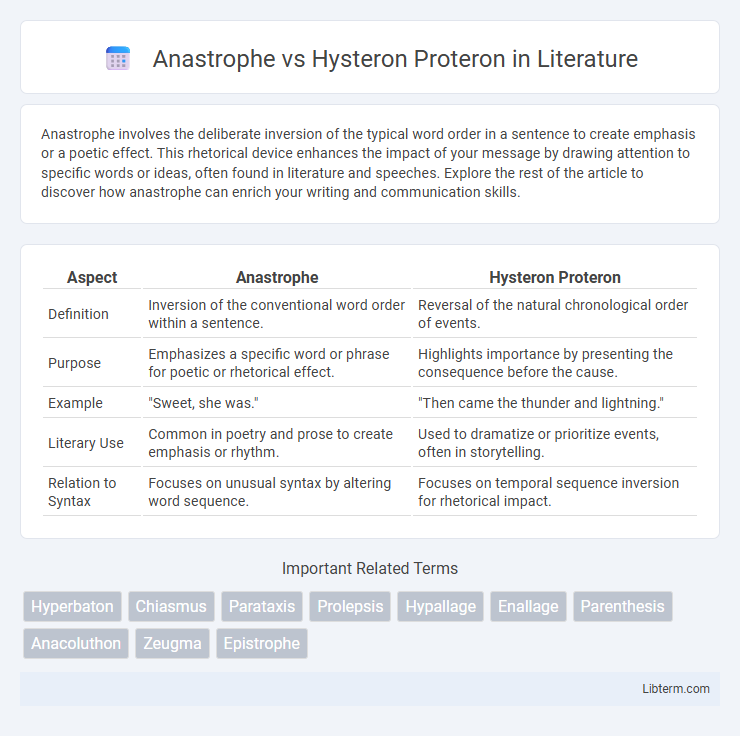Anastrophe involves the deliberate inversion of the typical word order in a sentence to create emphasis or a poetic effect. This rhetorical device enhances the impact of your message by drawing attention to specific words or ideas, often found in literature and speeches. Explore the rest of the article to discover how anastrophe can enrich your writing and communication skills.
Table of Comparison
| Aspect | Anastrophe | Hysteron Proteron |
|---|---|---|
| Definition | Inversion of the conventional word order within a sentence. | Reversal of the natural chronological order of events. |
| Purpose | Emphasizes a specific word or phrase for poetic or rhetorical effect. | Highlights importance by presenting the consequence before the cause. |
| Example | "Sweet, she was." | "Then came the thunder and lightning." |
| Literary Use | Common in poetry and prose to create emphasis or rhythm. | Used to dramatize or prioritize events, often in storytelling. |
| Relation to Syntax | Focuses on unusual syntax by altering word sequence. | Focuses on temporal sequence inversion for rhetorical impact. |
Introduction to Anastrophe and Hysteron Proteron
Anastrophe involves the inversion of the typical word order in a sentence to create emphasis or maintain meter, commonly used in poetry and rhetoric to draw attention to specific elements. Hysteron Proteron, a form of hyperbaton, places the expected later event or idea before the earlier one, deliberately reversing chronological or logical order for dramatic effect or rhetorical impact. Both figures of speech manipulate conventional syntax but serve distinct purposes: anastrophe rearranges components within a phrase, while hysteron proteron reorders entire concepts or actions.
Defining Anastrophe: Meaning and Usage
Anastrophe refers to the deliberate inversion of the typical word order in a sentence to create emphasis or a poetic effect, often placing an adjective after the noun it modifies, as seen in phrases like "worlds between" instead of "between worlds." This rhetorical device enhances imagery and highlights specific elements by disrupting the expected syntactic pattern. Common in classical literature and poetry, anastrophe adds stylistic variation and draws attention to particular words or concepts.
Understanding Hysteron Proteron: Definition and Examples
Hysteron proteron is a rhetorical device where the natural or logical order of events is reversed, placing the last event first to emphasize its importance. For example, "Put on your shoes and socks" demonstrates hysteron proteron, as socks logically precede shoes but are mentioned afterward for effect. This contrasts with anastrophe, which involves the inversion of usual word order within a phrase or sentence without necessarily changing the chronological sequence.
Grammatical Structure Differences
Anastrophe involves the inversion of the typical word order within a sentence to emphasize a particular element, often shifting adjectives or prepositional phrases ahead of their usual position. Hysteron proteron, however, rearranges events or ideas so that what logically comes last appears first, altering temporal or causal sequences rather than simple syntactic order. The key grammatical difference lies in anastrophe's manipulation of standard syntax for stylistic emphasis versus hysteron proteron's reordering of narrative or logical sequence to affect the interpretation of timing or priority.
Historical Origins and Literary Roots
Anastrophe and hysteron proteron both originate from classical rhetoric, with Anastrophe tracing back to ancient Greek and Latin poetry where word order was manipulated for emphasis or meter. Hysteron proteron, meaning "later earlier," emerged from Aristotelian and Roman rhetorical traditions, emphasizing the reversal of logical or chronological sequences to create dramatic effect. Both devices found rich literary roots in epic poetry, such as Homer's Iliad for Anastrophe, and Cicero's oratory for hysteron proteron, establishing foundational techniques for stylistic variation in Western literature.
Common Contexts in Literature
Anastrophe and Hysteron Proteron are rhetorical devices frequently employed in poetry and classical literature to enhance emphasis and create a unique narrative flow. Anastrophe, characterized by the inversion of the typical word order, often appears in epic poetry and Shakespearean plays to evoke a heightened emotional or dramatic effect. Hysteron Proteron, which places the natural chronological order of events in reverse, is commonly found in persuasive speeches and religious texts to stress urgency or priority of concepts.
Effects on Tone and Emphasis
Anastrophe, by inverting the usual word order, creates a poetic or dramatic tone that highlights specific elements for stylistic emphasis. Hysteron proteron rearranges events by placing the consequence before the cause, intensifying urgency and drawing attention to important actions or ideas. Both devices manipulate syntax to alter rhythm and focus, enhancing the emotional impact and thematic weight of a passage.
Notable Examples in Classic Works
Anastrophe, the deliberate inversion of natural word order, appears prominently in Shakespeare's *Julius Caesar* with the phrase "This I must see," emphasizing immediacy and dramatic tension. Hysteron proteron, a rhetorical device reversing chronological order, is famously employed in Virgil's *Aeneid* during Aeneas's summary of his journey: "I have seen the cities, I have crossed the seas," prioritizing significant outcomes over temporal sequence. Both devices enrich classical literature by manipulating language to highlight key themes and emotional states.
Semantic Implications for Readers
Anastrophe involves the inversion of the usual word order, enhancing emphasis by foregrounding specific elements and disrupting reader expectations, which encourages deeper engagement with the text's meaning. Hysteron-proteron reverses the natural sequence of events or ideas, creating a semantic tension that prompts readers to reconsider causality and temporal relationships, often highlighting the importance of outcomes before their causes. Both figures shape semantic interpretation by manipulating syntactic norms, thereby influencing how readers process, prioritize, and infer information within a narrative.
How to Distinguish Anastrophe from Hysteron Proteron
Anastrophe involves the inversion of the usual word order for emphasis or stylistic effect, such as placing an adjective after the noun it modifies. Hysteron proteron, by contrast, reverses the natural chronological or logical order of events or ideas, like mentioning the consequence before the cause. Distinguishing the two relies on identifying whether the inversion pertains to word order within a phrase (anastrophe) or to the sequence of ideas or events (hysteron proteron).
Anastrophe Infographic

 libterm.com
libterm.com